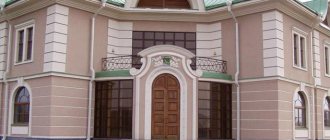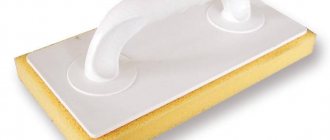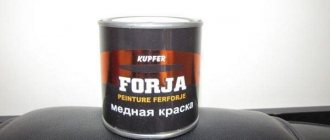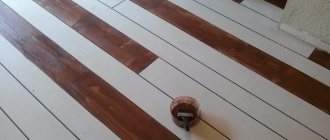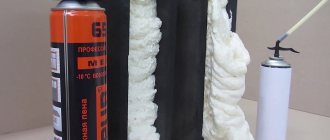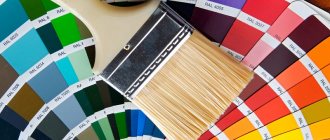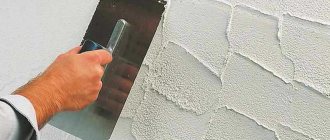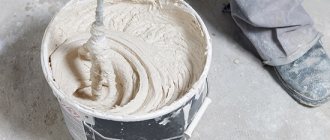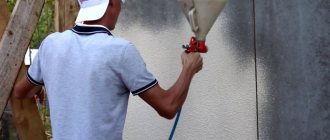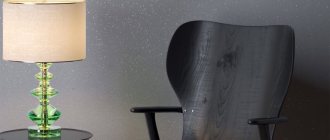Composition and features of acrylic paints
A lot of characteristics with a plus sign inherent in acrylic paints of this group arise from the composition - a dispersion (solution) of polyacrylic resins with additives.
- Acrylic copolymer monomers are the basis that determines the basic characteristics, combine and hold pigments and additives.
- Auxiliary monomers – make up up to 10% of the base and determine specific properties.
- Water, organic solvent - paints for interior work are usually water-dispersed, for facades - with water or organic solvents.
- Pigments – provide color, hiding power, and help increase resistance to ultraviolet radiation and other atmospheric influences.
- Modifying additives – regulate film formation, simplify the application process, and impart certain properties, for example, biocidal.
The paint is a viscous homogeneous mass without divisions into fractions, the consistency of which resembles liquid government sour cream. Due to the absence of typical solvents, acrylic paints, even facade paints, do not have a pronounced chemical odor. After drying, a thin, durable but permeable film is formed on the surface, freely allowing steam to pass through, but protecting the surface from all external influences.
Main manufacturing companies
Facade winter paint has become in demand in construction markets, so the list of manufacturers includes many well-known and not so well-known companies, including Russian and foreign ones. Since it is impossible to list everything, the famous and distinguished brands are presented below.
Tikkurila
The paint is a water-based type. The company produces two types of paint:
- Kivisil. A relative feature of this type is the matte structure that forms after coating. Manufacturers have achieved a high level of protection against frost and moisture using a silicone-based emulsion. For reliable protection, it is recommended to apply two layers of paint;
- Novasil. This paint differs from the previous one in its acrylic base. It should be applied exclusively to treated walls; this type refers to the finishing material for facade treatment.
The manufacturer guarantees reliable protection from moisture, frost and vapor barrier. Due to the silicone resin content, the characteristics of the paint are increased significantly.
Optimist
Paint made by Russian manufacturers. Two varieties:
- Water-based paint containing dispersion;
- Water-latex.
Both options are distinguished by high quality and ease of processing. Due to its structure, after application the paint evens out the surface. Manufacturers have taken care to create a rich color palette; it is possible to select a type for any facade structure. On construction markets the price ranges from 1500-1800 rubles.
Dulux
The manufacturing company specializes in the production of acrylic-based paint. Adapt to the structure of the facade. Professionals highlight the positive properties of this frost-resistant paint:
- Short drying time;
- Cost-effective;
- Adaptability to any surface;
- Service life – 15 years;
- After drying, an additional ability to self-clean from water and dirt appears.
The cost of paint on the construction market is 1,500 rubles.
Caparol
The paint is from a German manufacturer and has a range of colors and shades. Every year the market is replenished with new products manufactured in accordance with new technologies. Frost-resistant paint has earned popularity due to its quality and long service life.
The main feature of the brand is the long-term preservation of the original appearance; the facade is not afraid of snow, rain, or exposure to ultraviolet rays. Due to mass consumption, the manufacturer produces several types of paint based on:
- Oils;
- Acrylic;
- Water.
The cost of the product is higher than paint from a Russian manufacturer, this is due to its popularity and quality - 3000-3500 rubles.
Severol
An interesting property of the paint is that it does not lose its properties at negative and positive temperatures. Can be used in any weather conditions. The period for complete drying of the surface is 4-6 hours from the moment of application.
The paint has water-repellent properties due to the use of new technologies in production. You can choose paint for any surface. It can be applied to a façade with any structure, and the surface can be leveled.
Characteristics of acrylic paints
In fact, frozen acrylic film is the thinnest layer of plastic, hence the high technical and operational characteristics:
- Environmentally friendly - contains only safe components; Regardless of temperature conditions, the coating is not capable of releasing harmful substances into the air. There is no danger of poisoning during work, even with large volumes and without a respirator.
- Wear resistance – resistant to abrasion, ultraviolet radiation, mechanical and atmospheric influences, fluctuations in temperature and humidity conditions.
- Moisture resistance - after drying, the coating is not afraid of direct exposure to water, and the painted surface can not only be wiped, but also washed.
- Durability – the coating has excellent adhesion to almost any substrate (subject to proper preparation), and there is no possibility of peeling.
- Elasticity - the polymer base allows some movement of the base, due to which the coating maintains its integrity not only on static surfaces.
- Vapor permeability – the “breathable” film does not prevent the release of vapors, which allows the paint to be used on substrates with high vapor permeability.
- Covering power - the composition adheres well and effectively hides surface defects (up to 5 mm).
- Versatile - suitable for most indoor and outdoor substrates.
- Decorative – a wide palette and high hiding power make it possible to obtain the most presentable appearance of the painted surface. As is the case with other dyes, the desired color can not only be purchased ready-made, but also obtained by tinting on a special device or manually using specialized pigments. Acrylic paints are also available with various visual effects (mother of pearl, chameleon), which only adds to the spectacle of the coatings.
- Durability – manufacturers claim a coating lifespan of up to 15 or even 20 years. Given the properties of acrylate resin and its derivatives, it is quite possible that this is a reality. But, in the case when the technology of both preparation of the base and application is followed.
For indirect proof of good adhesion and strength, you can take one of the queries on the portal forum.
BearVG FORUMHOUSE Member
How to effectively and quickly remove a layer of acrylic paint and lime mortar from the facade to the plaster layer, if the layer consists of: acrylic paint->lime mortar->plaster layer. Interested in methods and methods for removing/cleaning from the facade. Sandblasting is not available. I tried it mechanically - it’s difficult if you use a metal brush or spatula; if you use a shovel as a scraper, it’s ineffective, just like with a hatchet.
How to choose façade paint for exterior work
Before choosing façade paint, you must first consider the coating material on which you plan to apply the coloring composition.
For wood
Wood is a material for which it is quite difficult to choose a coloring composition, since wooden walls:
- prone to rotting;
- absorb moisture;
- not resistant to fire.
For wood, the best option for painting would be a coloring composition that has a high level of moisture resistance, elasticity and good adhesion to the wooden surface.
IMPORTANT!
The most suitable cladding for wood is acrylic . It has good adhesion to the wooden surface, and also helps the wood underneath to “breathe”, is easy to apply and has a fairly long service life.
Both tinted and transparent paints are suitable for wood . When using a transparent coating, the structure of the natural texture is preserved. Transparent compositions are vapor-permeable, they help release moisture from the surface.
For brick
A brick surface requires special properties of coloring materials, since brick tends to remove accumulated salts, which adversely affects the appearance. In addition, moss and peeling may form on a brick wall. Due to this factor, it is recommended to paint the brick surface several years after the construction of the building.
To paint brick, painting materials must meet the following requirements:
- resistance to chemicals;
- vapor permeability;
- resistance to precipitation;
- mechanical stability.
To cover a brick wall, you need a substance that has good elasticity so that when there are temperature changes during the contraction (expansion) of the brick base, the coating does not crack or deform.
For brick, an acrylic coating may be the best option: it allows the brick to “breathe”, is resistant to moisture, and prevents the formation of efflorescence.
NOTE!
Sand-lime brick should be painted with silicate or cement compounds.
If the brick is ceramic, almost all types of coatings are suitable for it.
Water-based compositions are also good for painting brick, but it should be kept in mind that they are susceptible to moisture and are not suitable for finishing facades subject to frequent precipitation.
For foam block
Foam block walls are highly porous, so to protect the pores from dust and moisture, paint with vapor-permeable properties and at the same time water-repellent is required. The most suitable for foam blocks are silicone coatings or the expensive option - rubber.
CAREFULLY!
When painting with silicone compounds, the seams should be carefully sealed to avoid the formation of cold bridges.
Otherwise, the paint will peel off and collapse.
For concrete
Dull, gray concrete is often painted to add brightness of color, decorativeness, and also to protect the base. Despite the fact that concrete is a fairly durable material, it is subject to destruction over time.
The main requirements for concrete paint should be:
- frost resistance;
- moisture resistance;
- environmental friendliness;
- color fastness.
For concrete, you can use any composition, but you should take into account the characteristics of each type, which may negatively affect the result:
- water-based - weakly protects against moisture;
- oil-based - do not have vapor permeability and require thorough preparation of the surface for painting.
Manufacturers recommend using acrylic, silicone or rubber coatings.
Types of acrylic paints
Acrylic paints can be classified according to various criteria, from composition to specific properties. But given our focus, it makes sense to dwell in detail on the three main groups.
Acrylic paints for exterior use
This group is also called facade paints, since most often they are used specifically for painting the walls of houses, as well as bathhouses, utility rooms, fences, small forms, and garden decor. Facade paints are produced both with water and with an organic solvent, regardless of this, they are all designed for aggressive working environments. Modifying additives are aimed at increasing resistance to all types of influences - here are mechanical damage, precipitation, sudden temperature fluctuations, and direct sunlight. A surface painted with high-quality acrylic dye can later be washed with a hose without harm to the coating.
Acrylic paints for interior work
They are also interior paints, intended for painting surfaces that are not exposed to atmospheric influences. That is, a cold veranda can be painted, just like surfaces in the bathroom or kitchen, but if we are talking about an open gazebo, there is no need to risk it. Interior paints are predominantly water-dispersed, completely odorless, and are approved for use even in children's rooms.
Specialized acrylic paints
Manufacturers offer formulations for almost all occasions, and it is difficult to list the range item by item. A striking example of the group is acrylic paints with biocidal properties obtained by introducing a certain proportion of colloidal silver into the composition. Heat-resistant paints used for heating radiators are also in demand - budget or from the expensive segment.
Yuri Sokolov Member of FORUMHOUSE
You can paint not only with heat-resistant paint, but, for example, specifically with enamel for heating radiators. This is practically the same thing, however, heat-resistant paints are available up to 800⁰C, they are actually more expensive, and enamel for heating radiators, as a rule, is designed for temperatures up to 130⁰C and is cheaper for the same quality.
Varieties of frost-resistant paint
Before you start choosing a manufacturer, you need to decide and find out what types of frost-resistant paints for facades are divided into. In construction markets there are 3 types of paint based on:
- Water;
- Silicone and silicate;
- Variances.
To make it easier to make a choice, you need to know the features and characteristics of each option.
Water-based facade paint. The main distinguishing feature is that after purchase you can immediately proceed to application to coatings; there is no need to dilute or perform any manipulations with the product. A win-win option for beginners in the field of facade finishing. The result will please the consumer with a long service life; the building will not be exposed to various weather conditions.
Silicone and silicate based paint. Can be used regardless of the skill level of the specialist in conducting molar conditions. The structure allows you to select the ideal shade and paint the facade of the building in a short time. You can use silicone-based paint on concrete and metal in winter. Due to its elasticity, renovation professionals call it rubber paint.
In cases where wood work needs to be done, it is better to use frost-resistant paint that contains resins.
The main positive property of paint is that it has the property of self-cleaning and, due to its structure, allows the facade to breathe. A house treated with this type of paint takes on a modern and practical look.
It is possible to use dispersion-based paint, regardless of the structure and type of surface. Convenient and easy to use.
It is strictly forbidden to use frozen paints. Otherwise, damage to the structure will occur after thawing. Which will lead to destruction of the surface, and, consequently, to a short service life.
Frost-resistant paints for facades are usually divided into two subcategories:
- Acrylic;
- Oily.
Most consumers prefer the first option, which is facilitated by a number of positive characteristics:
- Long service life;
- A 100% environmentally friendly product that does not harm either humans or the environment;
- Easy to clean and breathable material;
- Ease of use, which is especially important for beginners.
To improve reliability and quality, the composition is applied to the surface twice, the main thing is to let the previous layer dry.
Oil paints are rarely used, as they are inferior in many respects to their competitors, acrylic. The complexity of the work done this way is many times greater than other options.
Scope of application
Due to the high technical and operational properties, the unlimited scope of application of acrylic paints is not surprising. They can be used on almost all types of bases, be it wood, concrete, stone or metal, with the exception of some types of plasterboards, which greatly simplifies the choice of materials when carrying out finishing or repair work. In the line of any manufacturer there is always paint for interior and exterior work in a wide range of colors, therefore, there will be the same quality of the painted surface and matching shades during transitions.
When choosing, it is worth considering that there are universal paints in terms of bases, but within the group they usually differ in the specific application - for walls, ceilings and floors. This is due to a practical component - these zones have different operating conditions, and they look different due to the different angle of incidence of light. And the application technique is different, which determines the consistency and composition of the additives.
The popularity of acrylic paints is also explained by the atypical color range - while standard floor enamels are overwhelmingly brown, acrylic ones can be of any color.
Vlademir FORUMHOUSE Member
My wife wants floors at home that are not the color of traditional floor paint, but light, with a brownish tint, that is, as light as possible. Nearby stores offer acrylic flooring; the manufacturer's assortment includes a light color. Does anyone have experience?
Eat.
Nika19 Member of FORUMHOUSE
We painted with water-soluble acrylic, the color was a straw. It turned out to be light-light yellow, a nice shade, I also love light floors.
Facade finishing technology
Given the wide variety of types of material, we will limit ourselves to only general rules regarding any paint.
- The first step is surface preparation . We inspect and detect dents, potholes, crumbling or peeling parts of plaster, old coatings, etc.
- All detected defects are eliminated . To do this, the wall is puttied, removing all problem areas (delaminations are chipped off, crumbling areas are removed and primed).
- In the most difficult cases, you have to plaster the entire wall.
- A period of time is required to allow the putty, primer or plaster to dry completely .
IMPORTANT!
The materials used must match the finish coating and provide high-quality adhesion to the surface.
- Application of paint requires suitable weather conditions . The weather should be dry (no rain), air temperature within +5 - +30°. Windy weather is also not good - dust or sand particles will stick to the freshly applied paint, ruining the entire job.
- To apply paint, hand tools are used - roller or brushes, or mechanical equipment - spray gun, spray gun, etc.
- The paint is applied according to the manufacturer's technology indicated on the packaging . The specified procedure is followed, the required number of layers is maintained, and the recommended paint viscosity is maintained. It should be remembered that the paint consumption stated in the documentation turns out to be somewhat higher in practice, since laboratory conditions are much more favorable than those that occur on site.
NOTE!
Particular attention should be paid to the interval between application of the first and second (subsequent) layers of paint . If you rush, you can ruin the entire surface of the wall, which will require repainting and lead to new expenses.
- Drying time is usually about a day , but in practice they only wait until the coating is ready for further work - installing hanging elements, lights, air conditioners, etc. Further final drying does not require human intervention and occurs automatically.
Technology and application nuances
No special skills are required when working with acrylic paints; on the contrary, they are characterized by ease of application and lack of drips. However, the lion's share of success lies in careful preparation of the surface to be painted and compliance with the manufacturer's recommendations.
Preparing the base
The specific algorithm of work is determined by the type of base - if wood often requires sanding, then it is enough to clean concrete/brick/stone from dirt and dust. But in any case, the base must be clean, durable and necessarily primed, preferably with a primer from the same manufacturer as the paint. At a minimum, the primer should be compatible with the acrylic paint. Again, primer for wood should have an antiseptic additive, and for metal – with anti-corrosion properties.
Inngrid Member of FORUMHOUSE
I'm about to paint a cast iron battery, I'm choosing from acrylic heat-resistant paints/enamels. They write everywhere that before painting with them it is better to prime the surface with anti-rust primer or a primer directly over the rust (there is rust on the surface of the battery in some places). What primers are suitable for acrylic enamel for radiators?
Yuri Sokolov
There are special primers for rust. There is a 3-in-1 enamel primer, but this is not for batteries; here it’s better to use a primer first. Cover the pre-prepared heating radiator with it. If you paint with acrylic paint, you can use almost any acrylic primer; if the volume is small, take the primer in an aerosol can.
The main thing is that there must be soil. Otherwise, not only will the consumption of not the most budget paint increase, but the quality of the final layer will also deteriorate. It is also important to observe the time interval between layers. How long the primer needs to dry depends on the specific brand, but modern products usually do not require too much downtime and dry in a few hours. If we are talking about loose surfaces with high absorbency, the primer is applied twice - the second layer after the first has dried.
Considering that the composition dries quickly enough so that you don’t have to spend time and tediously washing surfaces that are not intended for painting, you should use masking tape before applying paint. It will also help you get clear, even lines without bleeds if there is a gradation in color or imitation of panels.
Application of façade dyes to different types of surfaces
Very rarely, facade paint can be applied to the surface immediately, without preparation.
Almost always you need to perform a number of actions before this, namely:
- clean the surface of previous paint, dirt and dust;
- strengthen the surface layer, if necessary;
- seal cracks, if any;
- plaster (depending on the surface, this may not be necessary);
- coat the surface with a primer;
- paint.
There are many devices for painting; as a rule, the instructions tell you which one to use. You may need a roller or a wide brush, a spray gun or a special painting machine.
How to paint wood correctly?
A special feature of preparing wooden surfaces for coating with acrylic paint is their preliminary priming.
The following videos explain how to properly stain wood:
Price
The cost of acrylic compositions for treating external surfaces depends on many factors, including the region, manufacturer, brand and packaging.
For clarity, let’s present the average prices of the most common brands of acrylic paints:
- “OLIMP” (Russia) – 900 rubles for 5 liters;
- “Tex Profi” (Russia) – 2,700 rubles for 18 liters;
- “Sto Color Opticryl Satinmatt” (Germany) – 6,000 rubles per 10 liters;
- “JUB ACRYLCOLOR” (Serbia) – 6,000 rubles for 15 liters.
